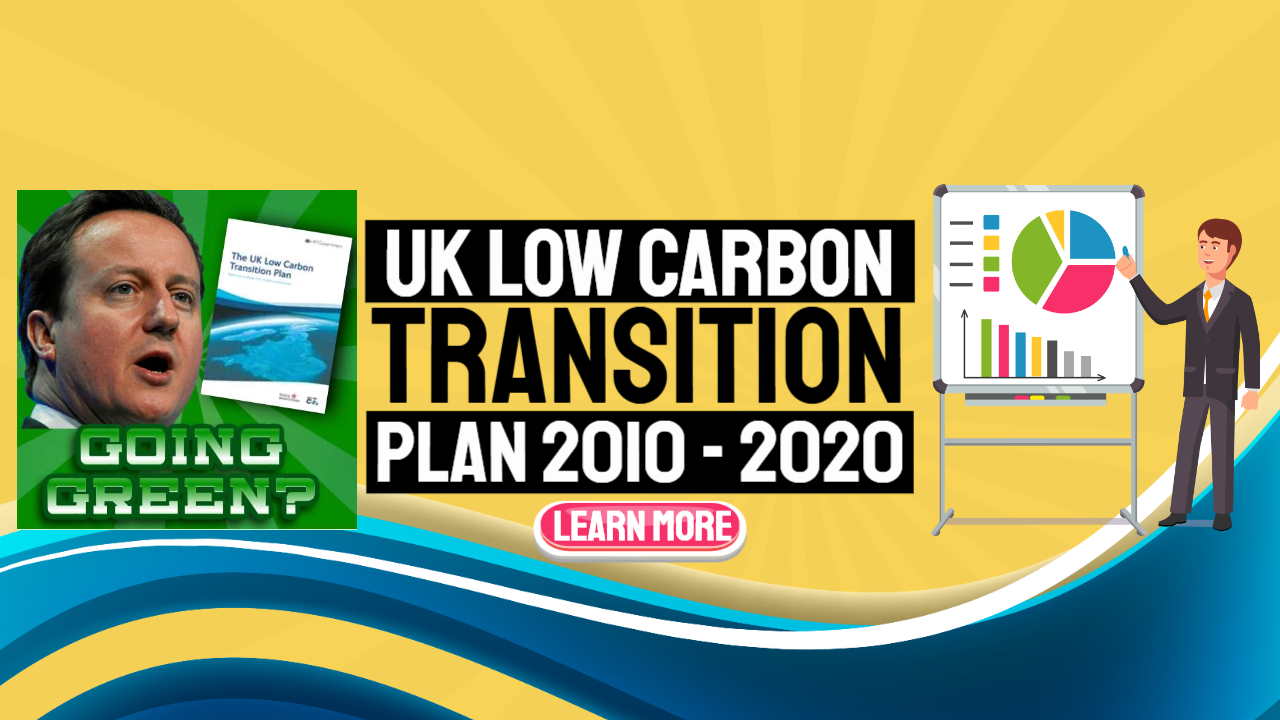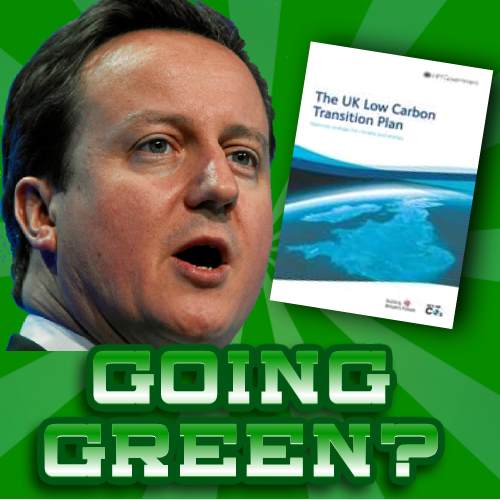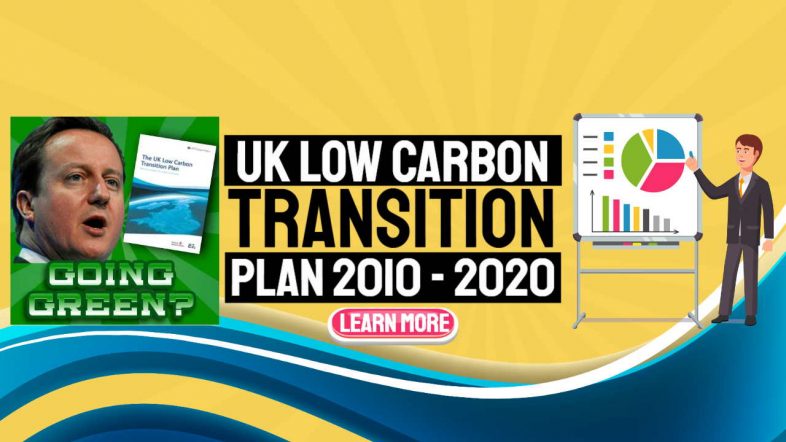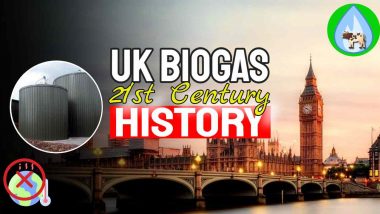The UK Low Carbon Transition Plan, which operated from 2010 to 2020, is no longer current.
It was a white paper explaining how the British economy would be reformed to guarantee the UK:
- reached its emission reduction targets,
- secured its future energy sources over the period covered,
- maximised economic prospects for employment, skills, and investment, and
- ensured policies were fair to safeguard society's most vulnerable.
It outlined the then-long-term government's plan to cut carbon emissions by 18% from 2008 levels (almost one-third from 1990 levels) by 2020 and achieve the country's first three carbon budgets. It is not a statement of government policy at this time.
It is understood that the policy worked, or maybe other factors simply allowed the needed carbon emissions reductions to occur.

The remainder of this page provides the “now historical” background to this piece of “first of a kind” GHG emissions reduction policy: Read on to find out more:
 The UK Low Carbon Transition Plan of 2015 seems long gone. It is easy to forget that, despite the 2010 – 2015 UK Coalition Government's lack of enthusiasm for green issues, the UK's world leading CO2 emissions reduction legislation is still in force.
The UK Low Carbon Transition Plan of 2015 seems long gone. It is easy to forget that, despite the 2010 – 2015 UK Coalition Government's lack of enthusiasm for green issues, the UK's world leading CO2 emissions reduction legislation is still in force. It became law in the Climate Change Act 2008, and the high ideals embodied in that Act remain and have been taken forward in the 2012 – 2013 Energy Bill in which the following primary UK climate change targets were finalized:
- 30% of electricity from renewable sources by 2020
- greenhouse gas emissions to be cut by 50% on 1990 levels by 2025 and
- greenhouse gas emissions to be cut by 80% on 1990 levels by 2050.
Currently (January 2015), the government maintains that the UK is on-target to achieve these reductions on time. However, there is a lot of progress still to be made, and it remains to be seen whether, when the new government establishes itself after the May 2015 elections, there will need to be additional measures taken to ensure that industry, and investment, remains on-track to achieve the goals of the Low Carbon Transition Plan.
Low Carbon Transition Plan: The Cuts in Co2 Emissions and Renewable Energy Contributions which Must be Achieved by 2020
The predicted breakdown of where this contribution would come from by 2020 was to be, as follows:
“Around 50% of the annual emissions cuts between now and 2020 will be achieved by further greening of the electricity mix. We expect 40% of the electricity we use in 2020 to come from low carbon sources – 30% from renewables, the rest from nuclear (including new build) and clean coal.”
“Around 15% of the annual emissions cuts between now and 2020 will be achieved making our homes more efficient and supporting small scale renewable energy.”
“Around 10% of the annual emissions cuts between now and 2020 will be achieved through greater efficiencies in our workplaces.”
“Around 20% of the annual emissions cuts between now and 2020 will be achieved by cleaning up the way we travel.”
“Around 5% of the annual emissions cuts between now and 2020 will be achieved by reducing emissions from agriculture, land use and waste.”
In the UK Low Carbon Transition Plan (pdf) it states in the timelines that by 2020:
“Around 12% of heat [will be] generated from renewable sources, equivalent to supplying 4 million households based on current heating demand”. (p. 22.)
“10% of transport energy to come from sustainable renewable sources“. (p. 24.)
Of course, the concern may arise that if the new government is led by the conservatives in coalition with UKIP, that they may seek to backtrack on existing commitments. That the claim that David Cameron told aides to ‘get rid of all the green crap‘, in November 2013, made by two UK Newspapers seemed credible, shows how far green issues have slid down the agenda within the present administration.
It is a far cry from 2009, during the previous Labour government when the Low Carbon Transition Plan was published, so we thought that we would provide below a copy of the UK Department of Energy and Climate Change Press Release, which summarizes the intentions of the Low Carbon Transition Plan:
DECC Press Release – UK at forefront of a low carbon economic revolution
15 July 09 – A comprehensive plan to move the UK onto a permanent low carbon footing and to maximise economic opportunities, growth and jobs was published by the Government today.
The UK Low Carbon Transition Plan plots out how the UK will meet the cut in emissions set out in the budget of 34% on 1990 levels by 2020. A 21% reduction has already been delivered – equivalent to cutting emissions entirely from four cities the size of London.
Transforming the country into a cleaner, greener and more prosperous place to live is at the heart of our economic plans for Building Britain’s Future and ensuring the UK is ready to take advantage of the opportunities ahead. By 2020:
- More than 1.2 million people will be in green jobs
- 7 million homes will have benefited from whole house makeovers, and more than 1.5 million households will be supported to produce their own clean energy
- 40% of electricity will be from low carbon sources, from renewables, nuclear and clean coal
- We will be importing half the amount of gas that we otherwise would
- The average new car will emit 40% less carbon than now.
The Transition Plan takes a cost effective route to reducing carbon and keeps the overall impact on the consumer to a minimum. Today’s plan will not increase average energy bills by 2015, compared to now. By 2020, the impact of ALL climate change policies, both existing and new, will be to add, on average, an additional 8% – or £92 – to today’s household bills. Since 2000 £20 billion has been spent tackling fuel poverty, assisting millions of households in the UK. The Plan includes greater powers for the regulator Ofgem to protect the consumer and, following new legislation, new resources for discounts off the bills of some of the most vulnerable households.
The Transition Plan is the most systematic response to climate change of any major developed economy, and sets the standard for others in the run up to crucial global climate talks in Copenhagen in December.
The UK Low Carbon Industrial Strategy, published alongside, sets out a series of active government interventions to support industries critical to tackling climate change. It puts workers and businesses in the UK at the forefront of massive global opportunity by targeting key industries and regions where the UK has competitive or commercial advantage, including offshore wind, marine power and carbon capture and storage. This includes the first allocations from the £405m funding for green industry and technology announced in the Budget.
Also published today are the Renewable Energy Strategy which maps out how we will deliver the UK’s target of getting 15% of all energy (electricity, heat and transport) from renewables by 2020, and the Government’s Low Carbon Transport Plan which sets out how to reduce carbon emissions from domestic transport by up to 14% over the next decade.
Energy and Climate Change Secretary Ed Miliband said:
“The UK was the first country in the world to legislate for carbon budgets. It was a dramatic change in approach. This is a transition plan for Britain, a route-map to 2020, with carbon savings expected across every sector and a carbon budget assigned to every government department alongside its financial budget.
“Renewables [which includes anaerobic digestion], nuclear and clean fossil fuels are the trinity of low carbon and the future of energy in Britain. Under our plans we will get 40% of our electricity from low carbon energy by 2020 and more in the years afterwards.
It is notable that the assertion was made that: “Today’s plan will not increase average energy bills by 2015, compared to now”. Of course, energy bills have risen, and many people have said that some of that rise has already been due to green energy subsidies.
The above is only part of the full article, which is available on the National Archives website here.
The UK Carbon Transition Plan is available here.
The image of David Cameron adapted for use here, was originally posted to Flickr by World Economic Forum at http://flickr.com/photos/15237218@N00/5433525697 (CC 2.0)
[This article was first published on 1 Feb 2015. Last updated August 2021.]





